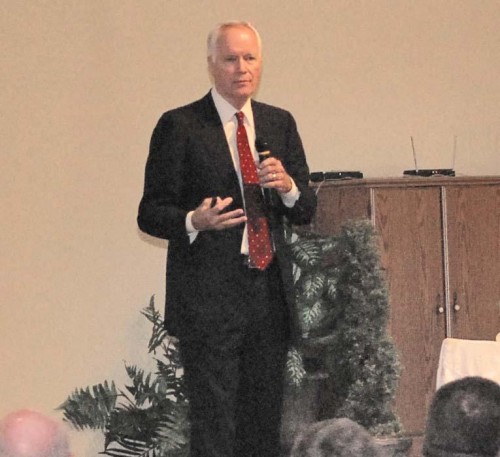
Deborah Carney
October 20, 2009
Mrs. Leontine (Tina) Harris
October 22, 2009The future is uncertain in the Houma-Thibodaux area for the oil and gas production industry and the companies that support the industry, said economist Loren Scott last week speaking at the Cypress Columns in Gray on his report “Louisiana Economic Outlook 2010-11.”
The professor emeritus at LSU co-authors an economic outlook report on the state annually, which includes an analysis of the Houma-Thibodaux metropolitan area.
“I’m concerned about what’s going on,” Scott said.
The Houma area is expected to lose 300 jobs in 2009. “That’s not much of a loss,” he said, especially compared to a projected loss of 1,400 jobs during 2009 in the Lafayette area, whose economy is also dependent on petroleum like Houma.
“But with oil prices at $70 a barrel, you should be going through the ceiling,” he said.
Job losses in the region were caused in part by cuts at oilrig platform makers Gulf Island Fabrication in Houma and J. Ray McDermott in St. Mary Parish.
However, Houma-Thibodaux is expected to gain 1,700 jobs through 2011. Edison Chouest’s new yard at the Port of Terrebonne for constructing deepwater vessels, LaShip, will be completed soon and employ around 1,000 new workers. Chouest is also opening a new dry dock at Port Fourchon, hoping to add 100 to 150 workers.
Gulf Island, whose jobs number fell from 1,200 to 850, is anticipating adding 350 workers through 2011. McDermott, with 350 employees, is expected to move back up to 600 in 2011.
In addition, North American Shipbuilding in Larose will add 600 jobs and Performance Energy Services in Houma will create 350 jobs with the opening of a marine repair yard at the Port of Terrebonne.
“But the oil and gas sector (in Houma) will be weak,” Scott said. “You will have gains in 2010 and 2011, but nothing like what you had after 1987.”
Employment in the Houma-Thibodaux metropolitan area rose almost continuously from 1987 to 2008, although two steep drops did occur during those years.
Two factors especially are helping to darken prospects for the local extraction industry, Scott said: a proposal by the Obama administration to eliminate $33 billion in tax credits for oil and gas companies, and lawsuits filed this year by Terrebonne against companies operating wells within the parish.
“There’s been a chill in the sector because of the Obama policy and the suits,” he said.
Obama’s 2010 budget proposes to get rid of tax breaks on “intangible drilling costs,” such as those for wages and pipelines, and allowances for depletion.
“This is because the greens are in charge,” Scott said.
Intangible drilling costs are “the heart blood of (oil companies’) ability to raise capital,” he said.
The rig count in Louisiana dropped sharply after Obama announced the proposal, Scott said. The weekly rig count was more than 180 when Obama took office and fell to below 130 during the summer.
“This tax does not have to pass, just talk about it and the rig count fell,” he said.
Oil companies will pass the cost of the tax on to consumers, according to Scott.
Terrebonne Parish Assessor Gene Bonvillain filed 31 lawsuits against oil and gas companies for allegedly underreporting activity at wells.
“He said oil companies owe taxes,” Scott said.
In September, Bonvillain said he and Don Briggs, president of the Louisiana Oil & Gas Association, “have two separate agendas,” responding to comments made by Briggs about the lawsuits.
Scott said oil companies are being criminally charged under the Racketeer Influenced and Corrupt Organizations Act in the suits and would have to pay triple damages.
Statewide, job losses of 11,000 in 2009 can be traced to two areas.
“We’re being held down by the oil patch and New Orleans,” Scott said. “There’s not much good to say about New Orleans.”
Louisiana is expected to gain 17,800 jobs in 2010, however.
The anticipated average price of oil per barrel is $85 in 2010 and 2011, ranging between $70 and $100. Scott said the reason for the wide range is the lack of free markets in countries like Saudi Arabia and Russia that contain oil supplies.
The price of natural gas will average $4.50 in 2010 and 2011, he said. The U.S. produces ample supplies and needs to import little natural gas. Scott said production should increase because of the huge Haynesville Shale deposit in Louisiana.
A conventional gas well produces 2 to 3 million cubic feet per day. Wells in the Haynesville field can turn out 22 to 24 million cubic feet per day.
Economist Loren Scott was slightly downbeat about prospects for the local oil and gas extraction industry during a talk in Gray last week. * Photo by KYLE CARRIER











